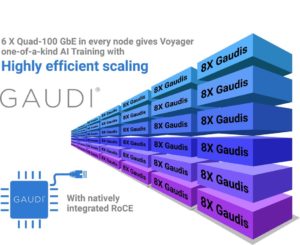Intel announced that the San Diego Supercomputer Center (SDSC) at UC San Diego will leverage Habana’s purpose-built artificial intelligence (AI) training and inference accelerators, with Intel Xeon Scalable processors, in SDSC’s Voyager supercomputer for high-performance and high-efficiency AI compute.

Habana Gaudi is the industry’s only AI processor to natively integrate ten 100-Gigabit Ethernet ports of RoCE v2
Expected to be in service in fall of 2021, Voyager is a first-of-its-kind in the National Science Foundation resource portfolio and will focus on advancing AI research across a range of science and engineering domains.
How it works
The Voyager supercomputer will use Habana’s unique interconnectivity technology to efficiently scale AI capacity with 336 Gaudi processors for training and 16 Habana Goya processors for AI inference.
Gaudi processors for AI training are architected for scaling large supercomputer training systems and are the industry’s only AI processor to natively integrate 10 100-gigabit Ethernet ports of RoCE RDMA v2 on chip, enabling flexibility of scaling and reduction of throughput bottlenecks that can limit scaling capacity.
“We are honored that Habana processors have been selected to accelerate compute workloads that will run on SDSC’s Voyager supercomputer,” said Eitan Medina, chief business officer at Habana, an Intel Company. “This implementation of our Gaudi and Goya products showcases how top academic institutions like SDSC can harness efficiency and performance to effectively address the growing computational demands of AI research workloads.”
Why it’s important
The first three years of Voyager’s operation will be the Testbed Phase, during which SDSC will work with select research teams from astronomy, climate sciences, chemistry, particle physics and other fields to gain AI experience and insights leveraging Voyager’s unique features. The documentation developed during the Testbed Phase will serve as a resource for an expanded user base.
“The level of performance and efficiency that Voyager will require is precisely what Intel architectures are designed for,” said Trish Damkroger, Vp and GM of Intel’s High Performance Computing Group. “Our Xeon Scalable processors coupled with Habana AI accelerators will ensure Voyager’s users have the HPC and AI capabilities they need to power their game-changing research.”
The Voyager will leverage the following AI systems:
- Supermicro X12 Gaudi AI Training System featuring eight Gaudi HL-205 cards paired with Intel’s newest high performance dual-socket 3rd Gen Intel Xeon Scalable processors.
- Supermicro SuperServer 4029GP-T featuring eight Goya HL-100 PCIe cards for AI inference, paired with dual-socket 2nd Gen Intel Xeon Scalable processors.
“Combining Supermicro’s advanced application-optimized server and storage hardware with Habana’s AI training and inference products is the best solution for SDSC’s multiyear Voyager AI project,” said Ray Pang, VP of Technology and Business Enablement, Supermicro. “We continue to work closely with leading innovators to deliver solutions for computationally intensive projects worldwide at leading research and HPC environments for science and medical discovery, compute and leading-edge AI solutions.”
The Voyager supercomputer buildout, with ongoing community support and operations, are funded by a grant from the National Science Foundation.
Filed Under: News


Questions related to this article?
👉Ask and discuss on Electro-Tech-Online.com and EDAboard.com forums.
Tell Us What You Think!!
You must be logged in to post a comment.